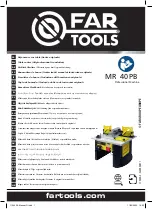
Chapter 1: Configuration
Configuring radio parameters
Page
1-211
Type of traffic in a sector
Besides the number of SMs, the other main factor in contention slots selection is the type of traffic. If
the sector experiences a lot of uplink traffic composed of small packets, for example in a sector that
serves several VoIP streams, the average number of bandwidth requests transmitted by each SM is high.
Another scenario with constant uplink traffic is video surveillance, which also generate a large number
of uplink bandwidth requests.
In these cases, the probability of two or more SMs transmitting a request in the same symbol is high.
When this happens, the latency of the system increases, and it is recommended to increase the number
of contention slots from the number in
. If an AP is experiencing latency or SM-servicing issues,
increasing the number of contention slots may increase system performance, depending on traffic mix
over time.
Recommendation on Contention Slots number selection
1.
Calculate the number of active SMs in the sector.
2.
Evaluate the traffic mix that is expected in the sector, more specifically the expected
percentage of real-time traffic (ex. VoIP, gaming, video conferencing, and video surveillance).
3.
If the expected amount of real-time traffic is small, select the number of contention slots
according to
4.
If the expected amount of real-time traffic is large, select a number of contention slots larger
than the number in
5.
Monitor latency in your system. If the percentage of real-time traffic increases and the sector
experiences increasing latency and SM-servicing issues, increase the number of contention slots
from the current setting.
This is the reason why the maximum number of contention slots is 15, even if Table 2 shows 8
contention slots for more than 150 data channels. If the number of data channels is more than
150 and a significant portion of the traffic is real-time, the frequency with which bandwidth
request messages are transmitted requires a higher number of contention slots, potentially as
high as 15. A sector with a high number of video surveillance cameras would also require a
larger number of contention slots to reduce the probability of collision between requests.
6.
Monitor the percentage of BW requests successfully received and the UL frame utilization: if the
frame utilization is high (close to 100%), then it is not recommended to change the number of
contention slots, even if the percentage success rate of BW requests is low. However, if the
percentage success rate of BW requests is low and the frame utilization is also low, then
increasing the number of contention slots is recommended.
Cluster of APs
It is recommended to use care when changing the contention slots configuration of only some APs in a
cluster, because changes affect the effective downlink/uplink ratio and can cause co-location issues.
In a typical cluster, each AP should be configured with the same number of contention slots to assure
proper timing in the send and receive cycles. The number of contention slots is used by the frame
calculator to define the downlink and uplink times, which should not overlap from one AP to another.
However, if the traffic experienced by two APs in the same cluster is different (for example, one
supports significantly more VoIP traffic), the number of contention slots selected for each AP may not
be the same. For APs in a cluster of mismatched contention slots setting, it is recommended to use the
frame calculator to verify that send and receive times do not overlap (see the
).
Summary of Contents for PMP 450 AP
Page 51: ...Chapter 1 Configuration Quick link setup Page 1 23 ...
Page 155: ...Chapter 1 Configuration Configuring security Page 1 127 ...
Page 163: ...Chapter 1 Configuration Configuring security Page 1 135 ...
Page 164: ...Chapter 1 Configuration Configuring security Page 1 136 ...
Page 193: ...Chapter 1 Configuration Configuring radio parameters Page 1 165 ...
Page 194: ...Chapter 1 Configuration Configuring radio parameters Page 1 166 ...
Page 195: ...Chapter 1 Configuration Configuring radio parameters Page 1 167 ...
Page 206: ...Chapter 1 Configuration Configuring radio parameters Page 1 178 ...
Page 210: ...Chapter 1 Configuration Configuring radio parameters Page 1 182 ...
Page 636: ...Chapter 5 Troubleshooting Logs Page 5 16 Figure 95 SM Authorization log ...
















































